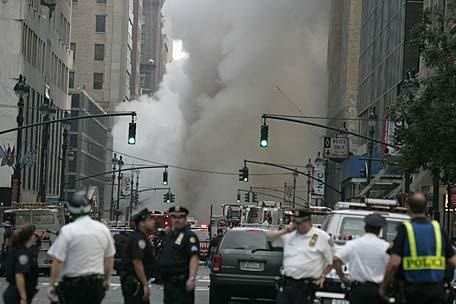
NYC Steam Blast
Explosion in Midtown Manhattan
Manhattan Midtown Steam Pipe Explosion
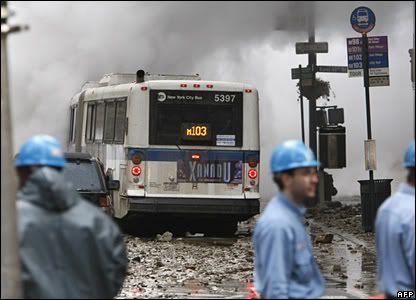
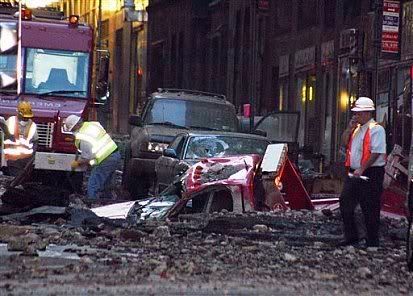
Huge Steam Pipe Blast Panics NYC
An underground steam pipe explosion blasted through a midtown street killing one, 30 hurt
http://abcnews.go.com/US/wireStory?id=3391889&CMP=OTC-RSSFeeds0312
An underground steam pipe explosion tore through a Manhattan street near Grand Central Terminal on Wednesday, swallowing a tow truck and killing one person as hundreds of others ran for cover amid a towering geyser of steam and flying rubble. Mayor Michael Bloomberg said the explosion was not terrorism, though the blast caused a brief panic about a possible attack.
"There is no reason to believe whatsoever that this is anything other than a failure of our infrastructure," he said of the 24-inch steam pipe installed in 1924.
One person was pronounced dead at Bellevue Hospital from an apparent heart attack, Bloomberg said. About 30 people were injured, at least four seriously. Authorities could not immediately account for how the most seriously wounded victims were injured.
The explosion caused widespread chaos as residents and commuters heard a huge blast and feared for the worst. Thousands of commuters evacuated the train terminal, some at a run, after workers yelled for people to get out of the building.
A geyser of steam and mud shot from the center of the blast, generating a tremendous roar. The initial burst of steam rose higher than the nearby 77-story Chrysler Building, one of Manhattan's tallest buildings.
A city bus was abandoned in the middle of Lexington Avenue, covered with grit. A woman who was bleeding profusely was being helped by police while a man lay on a stretcher in the street.
Soot fell from the sky, covering some pedestrians. Others looked wet. The sky was blackened. And people wandered aimlessly, not knowing where to go.
Debbie Tontodonato, 40, a manager for Clear Channel Outdoor, said she thought the rumble from the 6 p.m. explosion was thunder.
"I looked out the window and I saw these huge chunks that I thought were hail," she said. "We panicked, I think everyone thought the worst. Thank God it wasn't. It was like a cattle drive going down the stairs, with everyone pushing. I almost fell down the stairs."
Heiko H. Thieme, an investment banker, had mud splattered on his face, pants and shoes. He said the explosion was like a volcano. "Everybody was a bit confused, everybody obviously thought of 9/11."
Streets were closed in several blocks in all directions. Subway service in the area was suspended.
The Buildings Department determined late Wednesday that nearby buildings were structurally sound but suffered some water damage and broken windows. Several feet of street near the 25-foot crater was in danger of collapse.
There were also concerns about what was spewed into the air. Some of the pipes carrying steam through the city are wrapped in asbestos. "The big fear that we have is there may or may not have been asbestos release," Bloomberg said.
Officials wouldn't know test results until later, the mayor said, but if there was a release it may have washed away with the water that came with the steam.
The steam cleared around 8 p.m., exposing a crater several feet wide in the street. A red tow truck lay at the bottom of the hole.
Con Edison spokesman Chris Olert said workers were still trying to determine what caused the blast. Kevin Burke, the head of the utility, said the site had been inspected earlier Wednesday after heavy rains flooded parts of the city, but crews found nothing at that time.
Millions of pounds of steam are pumped beneath New York City streets every hour, heating and cooling thousands of buildings, including the Empire State Building.
The steam pipes are sometimes prone to rupture, however. In 1989, a gigantic steam explosion ripped through a street, killing three people and sending mud and debris several stories into the air.
That explosion was caused by a condition known as "water hammer," the result of condensation of water inside a steam pipe. The sudden mix of hot steam and cool water can cause pressure to skyrocket, bursting the pipe.
NYC Manhattan Explosion
Steam explosion causes scare in NYC
http://news.yahoo.com/s/ap/20070718/ap_on_re_us/manhattan_explosion
NEW YORK - An underground steam pipe explosion tore through a Manhattan street near Grand Central Terminal on Wednesday during the evening rush hour, sending residents running for cover amid a towering geyser of steam.
New York Police Department spokesman Paul Browne said it was not terrorism related. A fire department spokeswoman said some people were taken to area hospitals, but no details were available. Subway service in the area was suspended because of the explosion.
A plume of steam, sometimes white and sometimes muddy brown, shot into the air from a gaping hole in the street near the train station and was as high as the nearby Chrysler Building. The air near the site was filled with debris.
Heiko H. Thieme, an investment banker, had mud splattered on his face, pants and shoes. He said the explosion was like a volcano. "Everybody was a bit confused, everybody obviously thought of 9/11."
Darryl Green, who works with AT&T, said the buildings shook, so he and his colleagues dashed down 30 flights of stairs.
"As we came out onto the street, the whole street was dark with smoke," he said.
A small school bus was abandoned just feet from the spot where the jet spewed from the ground.
Thousands of commuters evacuated the train terminal, some at a run, after workers yelled for people to get out of the building.
Debbie Tontodonato, 40, a manager for Clear Channel Outdoor, said she thought the rumble from the explosion was thunder.
"I looked out the window and I saw these huge chunks that I thought were hail," she said. "We panicked, I think everyone thought the worst, thank God it wasn't. It was like a cattle drive going down the stairs, with everyone pushing. I almost fell down the stairs."
Streets were shut down in several blocks in all directions.
Millions of pounds of steam are pumped beneath New York City streets every hour, heating and cooling thousands of buildings, including the Empire State Building.
The steam pipes are sometimes prone to rupture, however. In 1989, a gigantic steam explosion ripped through a street, killing three people and sending mud and debris several stories into the air.
That explosion was caused by a condition known as "water hammer," the result of condensation of water inside a steam pipe.

N.J. woman identified as steam blast's lone casualty
http://www.nj.com/news/index.ssf/2007/07/nj_woman_identified_as_steam_b.html
A New Jersey woman has been identified as the lone casualty in Wednesday's steam explosion in Manhattan.
Lois Baumerich, 57, of Hawthorne, Passaic County, died of cardiac arrest in the blast that left a gaping crater in the heart of midtown Manhattan, police said.
She and 15 other people were taken to Bellevue Hospital, said hospital spokesman Stephen Bohlen. Two seriously injured patients were being treated in the hospital's trauma unit. The remainder suffered minor injuries, he said.
Two people were in critical condition at New York Weill-Cornell Medical Center, said hospital spokeswoman Emily Berlanstein.
Among the injured were several firefighters and police Officer Robert Mirfield, who helped evacuate 75 people trapped in a nearby office building by cutting open a gate, authorities said.
Huge Blast Puts New Yorkers on Edge
http://news.aol.com/story/_a/huge-blast-puts-new-yorkers-on-edge/20070718190309990001
NEW YORK (July 19) - A massive geyser of steam and debris that erupted through a midtown Manhattan street left asbestos in the dust that settled, but city officials Thursday said tests indicated the air was safe of the carcinogen.
Tests were continuing, but the city's Office of Emergency Management said in a statement that long-term health problems were "unlikely."
Mayor Michael Bloomberg had said the possibility of asbestos contamination was the main health concern after an 83-year-old steam pipe ruptured less than a block from Grand Central Terminal, spewing a skyscraper-sized blast of steam, dirt and debris into the air.
Some of the city's older pipes that pump steam beneath the city to heat and cool thousands of buildings are wrapped in asbestos, which can cause fatal lung disease, though the disease is typically linked to prolonged exposure.
Crews worked overnight to assess and repair the damage and determine what happened.
One woman died of an apparent heart attack when the pipe erupted, and about 30 other people were injured, at least four seriously.
Officials quickly ruled out terrorism, but for some witnesses, the explosion, dust, debris and chaos were frighteningly reminiscent of the scene on Sept. 11, 2001.
"We were scared to death. It sounded like a bomb hit or a bomb went off, just like 9/11. People were hysterical, crying, running down the street," said Karyn Easton, a customer at a salon a few blocks from the site of the blast. "It was really surreal."
Thursday morning, stretches of several major thoroughfares in the area remained closed. Most subway service was restored, though the trains continued to bypass Grand Central.
Eight air samples in the area around the explosion found no sign of asbestos, but six of 10 samples of debris and dust came back positive, the emergency-management agency said Thursday. Residents in the area were to keep windows closed, and anyone exposed to the falling debris was instructed to wash carefully and isolate the clothing they were wearing in plastic bags.
City engineers warned that up to six feet surrounding the giant hole might be in danger of further collapse, and officials said workers would not be allowed into office buildings in a zone that covered several blocks. The Buildings Department determined late Wednesday that nearby buildings were structurally sound but some had suffered water damage and broken windows.
The cause of the rupture remained under investigation.
Officials said the pipe might have exploded under pressure caused by an infiltration of cold rainwater, or might have been damaged by a water main break.
Con Edison head Kevin Burke said the site had been inspected hours before the blast as part of a routine response to heavy rain that flooded parts of the city. He said crews had found nothing as they searched for steam rising from manhole covers or cracks in the street _ indications that pipes could be in jeopardy. The steam systems are normally inspected every six weeks.
It was rush hour Wednesday evening when the geyser erupted, generating a tremendous roar as 200-degree vapor sprayed as high as the top of the nearby Chrysler Building. Steam and dirt boiled from the ground for hours.
Many people were struck by falling chunks of asphalt or rock that had been blasted out of the ground. Mud covered some bystanders. A woman who was bleeding heavily was helped by police while a man lay on a stretcher in the street.
When the steam dispersed almost two hours later, a large crater was visible in the street and a red truck lay at the bottom of the hole. Two city buses and a small school bus sat abandoned and covered with grit in the middle of Lexington Avenue.
The steam pipes have ruptured before. In 1989, a steam pipe explosion near Gramercy Park killed three people and spewed loads of asbestos into the air _ a fact that Con Ed later admitted it concealed for days while residents were exposed.
That explosion was caused by a condition known as "water hammer," in which water condenses in a closed section of pipe. The sudden mix of hot steam and cool water can cause pressure to skyrocket, bursting the pipe.
Authorities Thursday couldn't immediately account for how the most seriously wounded victims of the latest eruption were hurt. Police said the woman who died, identified as Lois Baumerich, 57, of Hawthorne, N.J., suffered cardiac arrest.
She and 15 other people were taken to Bellevue Hospital, where two seriously injured patients were being treated in a trauma unit, hospital spokesman Stephen Bohlen said. Two other people were in critical condition at New York Weill-Cornell Medical Center, said hospital spokeswoman Emily Berlanstein.
Among the injured were several firefighters and police Officer Robert Mirfield, who helped evacuate 75 people trapped in a nearby office building by cutting open a gate, authorities said.

Asbestos in Manhattan explosion debris: officials
http://ca.today.reuters.com/news/newsArticle.aspx?type=topNews&storyID=2007-07-19T131027Z_01_N18418871_RTRIDST_0_NEWS-NEWYORK-EXPLOSION-COL.XML&archived=False
NEW YORK (Reuters) - Debris from an explosion of an aging steam pipe in midtown Manhattan contained asbestos, New York authorities said on Thursday, but no airborne samples of the dangerous mineral fiber were detected.
Six square blocks remained cordoned off around the site of the blast that shook buildings at about 6 p.m. on Wednesday, creating a towering geyser of debris and sending people fleeing in scenes reminiscent of the September 11 attacks.
Officials ruled out terrorism as the cause of the explosion that sent boiling, brownish water and steam gushing at least 120 feet high, saying it could have been caused by cold water getting into the pipe. One person died of cardiac arrest and about 20 others were injured, some seriously.
Subway services on Manhattan's crowded East Side were still disrupted on Thursday morning and around 20 blocks of Park, Lexington and Third Avenue were still closed to traffic. Subway trains were bypassing Grand Central Station, which was close to the explosion.
"Air monitoring confirmed no airborne asbestos, however, several of the numerous samples of muddy debris taken from the area were found to contain asbestos," Power utility Consolidated Edison said in a statement.
The company appealed for anyone in the explosion area to hand in any belongings covered in dust or debris in a plastic bag, so they can be disposed of safely, and urged people still inside buildings in the blast zone to keep windows closed.
"While exposure to asbestos over many years carries known health risks, the brief exposures people may have experienced after last night's steam pipe break are not likely to cause long-term health consequences," said New York City officials.
Asbestos, a once-popular fire retardant, causes some illnesses, particularly lung ailments.
"MIDTOWN VOLCANO"
The explosion left a crater about 20 feet wide on Lexington Avenue at 41st Street, one of the busiest areas of New York City near the Grand Central transportation hub.
The street and buildings around the site were still caked in mud and debris on Thursday morning and a red tow truck was still in the crater.
Marvin Factor, 60, a banker, was stopped from getting to his office in the blast zone by police wearing breathing masks.
"If police are here wearing these masks there must be an issue (with the air quality)," he said. "We deserve to know about it. Aside from 9/11 I don't remember anything as disruptive as this happening."
The scene of the explosion evoked memories of buildings collapsing in a billow of debris as they did on September 11, 2001, when the World Trade Center in lower Manhattan was destroyed.
Pedestrians sprinted from the scene, many with cell phones stuck to their ears, some crying. Some were covered in white ash and soot, others in mud. Newspapers showed pictures of shoes lying on the street, discarded by people as they fled the scene.
The New York Post headline dubbed the blast a "Midtown Volcano," and the Daily News said "The Earth Opened."
The steam pipe of 24 inches in diameter was installed under Lexington Avenue in 1924, and it carried steam for a variety of industrial purposes. Its explosion is the latest public embarrassment for ConEd, which is under scrutiny for power blackouts.
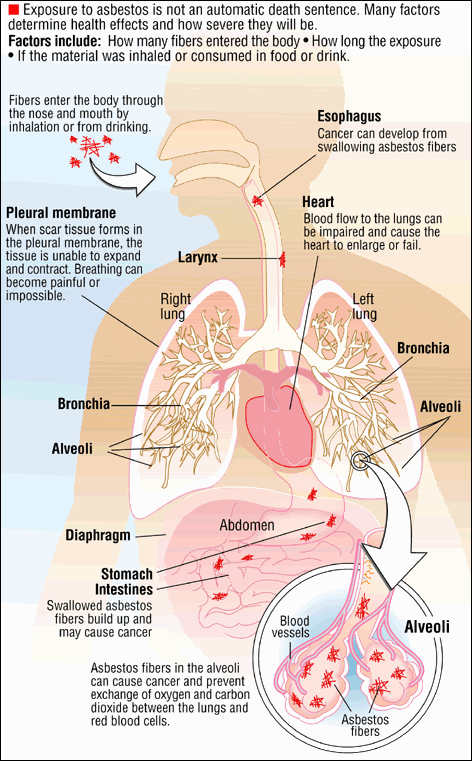
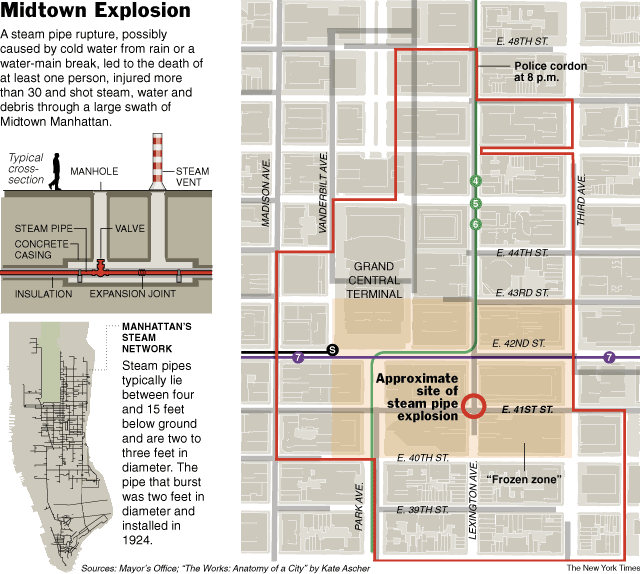
Asbestos Is in Debris From Explosion, but Not in the Air
http://www.nytimes.com/2007/07/19/nyregion/19cnd-explode.html?hp
Asbestos has been found in the muddy dirt and debris from a thunderous steam pipe explosion that jolted Midtown Manhattan on Wednesday evening. But no asbestos was found in the air, as Mayor Michael R. Bloomberg and others had initially feared.
New York City officials said today that it is unlikely that anyone will have long-term health effects from brief exposure to the asbestos.
“Developing an asbestos-related illness after being exposed for a short time — even at high levels — is very unlikely,” city officials said this morning. “Although we can never say if something is completely safe, from all the information we have obtained, there are unlikely to be long-term physical health consequences.
Asbestos is a known carcinogen. Most health officials say there is no safe level of exposure. But asbestos-related diseases generally are linked to sustained exposure in industrial settings over many years.
The streets around the area of the explosion near Grand Central Terminal remained closed this morning and city officials created a “frozen area” where people cannot enter because of cleanup and environmental tests.
The transit system was returning to normal, but some subway lines bypassed Grand Central or remained closed. The Metro-North Railroad was running on a regular schedule, but riders could enter Grand Central only through the Met Life Building and Grand Central North at 47th Street.
The explosion on Wednesday evening propelled a giant scalding jet of brownish steam toward the sky, sending commuters who had been heading home stampeding to safety.
One person died, officials said, and more than 30 were hurt, two of them critically. The city said that three firefighters and one police officer were among the injured.
The blast, near 41st Street and Lexington Avenue, raised fears of terrorism, but officials were quick to dismiss that possibility. “There is no reason to believe this is anything other than a failure of our infrastructure,” Mayor Bloomberg said.
The explosion sent up a foul cloud of hot steam mixed with mud, rust-colored gunk and pieces of pavement just before 6 p.m. in one of the busiest parts of the city. The mayor said that some telephone lines had been knocked out, but that electric power had not been.
Right after the blast on Wednesday, the mayor urged people who might have come into contact with mud or soot from the blast to wash carefully, and to have their clothes cleaned separately as soon as possible.
Jessica Leighton, a deputy commissioner at the Department of Health and Mental Hygiene, also cautioned people inside buildings near the blast to close windows and set air-conditioners to recirculate the air inside instead of drawing in air from outside.
As people on the sidewalks scrambled to flee the blast and office workers in the buildings above looked down in horror, debris from the geyser pelted nearby skyscrapers. Then it rained on the streets like a sudden hailstorm. Some witnesses said the jet of steam roared like Niagara Falls.
Some people ran so fast their shoes came off. Others dropped their briefcases and purses. Men in tailored suits were caught in a lapel-singeing cloud. At a health club high up in the Grand Hyatt hotel next to Grand Central, people working out on the treadmills said the explosion was so powerful they worried the building would collapse. The steam shot up from a crater that looked like that of a volcano, with orange flames and bubbling mud around the edges. The explosion packed enough force to flip over a tow truck that ended up in the crater, which was about 35 by 40 feet. Several hours after the blast, officials said the crater could grow even larger because pavement at the edges was in danger of collapse.
The cloud of steam — and the hail of debris that followed — lasted more than two hours and immediately raised concerns about asbestos, which was used when the pipe was laid in the 1920s. Officials advised people who had been in the neighborhood to discard their clothes and bathe carefully.
The mayor said the explosion appeared to have been caused by cold water that reached the pipe, which measured more than a foot and half in diameter and dated to 1924. “Cold water apparently causes these to explode,” he said.
Con Edison, which maintains the steam pipes beneath the city’s streets, said the pipe ruptured at 5:56 p.m. Kevin Burke, the chairman of Con Edison, said crews had checked the pipe after the thunderstorm that soaked the city in the morning. He said a heavy rain can cause a “vapor condition” if rainwater seeps onto a steam pipe, causing the steam to condense. He said the inspection earlier in the day had given no indication that anything was amiss.
There have been more than a dozen steam pipe explosions in the city in the last 20 years. One of the largest shook the neighborhood around Gramercy Park in 1989 and did millions of dollars in damage. Three people were killed, two of them Con Edison employees who had been working in the street before the explosion.
The explosion on Wednesday began with a deep, rumbling noise. “It was, like, surreal, man, this rumbling, like Old Faithful,” said Randy Rocha, a bus driver who was pulling away from a stop on 42nd Street with about 20 passengers aboard when the pipe ruptured.
He described plunging into the suddenly dark street. His uniform was splattered with mud the way a housepainter’s clothes are splattered with color. Mr. Rocha could not read his wristwatch — it too was covered with mud.
In the skyscrapers that surround Grand Central, office workers realized that what they were hearing were not the usual sounds of the evening rush, of buses hitting manhole covers or dump trucks changing gears.
“It sounded at first like thunder, but it just didn’t end,” said Andrew T. Frankel, a lawyer whose office is at Lexington Avenue and 43rd Street.
Tabi Freedman, an information technology specialist who was walking out of Grand Central, said, “The ground was moving, the windows were rattling, and me and everybody else, we all looked up.” She added, “I’ve been to Yellowstone, and that’s what I thought of — the pitch, the volume, the shrieking, the steam and the vibration.”
Ken Houghton, a consultant who works at 101 Park Avenue, between 40th and 41st Streets, said he first thought what was coming down was hail. “Then we saw rocks hitting the window on the seventh floor,” he said. Officials said later that six nearby buildings had sustained minor damage, mainly to windows on the lower floors.
More than 250 firefighters and 300 police officers were sent to the area. The Fire Department treated the blast as if it were a five-alarm blaze, and firefighters who approached the geyser had breathing tanks on their backs. Before long, ambulances were slicing past the stalled cars and buses, and were taking people who had been caught in the shower from the geyser to hospitals.
A trauma worker at Bellevue Hospital Center estimated that a dozen patients suffering minor injuries were taken there. Most of the injuries appeared to have been caused by falling debris; one person sustained a broken ankle, he said. As a precaution, patients were stripped and showered when they arrived.
The one death reported from the explosion was apparently caused by a heart problem. The victim, a woman, had apparently been close to the explosion, he said.
Mr. Burke of Con Edison said a number of 13,000-volt feeder cables for the utility’s electric system had been damaged in the explosion. He said crews would lay new cables under the streets to bypass the damaged ones. He said that 15 to 20 buildings that tap into the steam pipes had been taken out of service.
Five hours after the explosion, wisps of steam continued to rise from the crater. Lexington Avenue remained closed, with barricades keeping onlookers two to four blocks away and emergency vehicles lining the street — ambulances, fire trucks, tractors and fork lifts. The Lexington Avenue subways were running, but were not stopping at 42nd Street.

STEAM BLAST A DEADLY HELL
* 1,000S FLEE CHAOS OF DEBRIS SHOWER
* TERROR RULED OUT AMID ECHOES OF 9/11
http://www.nypost.com/seven/07192007/news/regionalnews/steam_blast_a_deadly_hell_regionalnews_brigitte_williams_james__dan_kadison_and_leela_de_krester.htm
A rumbling steam-pipe blast blew a 15-by-25-foot crater in a Midtown street yesterday, spewing a geyser of near-boiling water, gluey muck and rocks 120 feet into the air and onto terrified spectators as they ran for their lives.
A woman died of a heart attack, and at least 30 other people were hurt, two critically - including a man whose tow truck was hurled into the huge asphalt and concrete hole.
The explosion rocked East 41st Street between Lexington and Third avenues minutes before 6 p.m.
The blast of 200-degree steam:
* Created a "frozen zone" between East 40th and 43rd streets and Vanderbilt and Third avenues that was off-limits to anyone living in apartments there, and to all vehicular traffic.
* Disrupted subway service on the 4, 5 and 6 subway lines until early today.
* Forced testing for possible asbestos contamination from the 83-year-old steam pipe; initial tests by the city showed no asbestos contamination in the air, but it was detected in debris.
* Triggered the evacuation of thousands from nearby streets and Grand Central Terminal.
"We stood there, with the steam coming down and rocks coming down," said Kieran Beer, 50, a financial journalist as he held the arm of bleeding, dazed woman covered in mud and blood.
Officials quickly ruled out terrorism, although it was on everyone's mind.
"It looked like the World Trade Center had exploded," said Reggie Evans, an office administrator. "As I was running, I got pelted in the head by rocks and concrete."
Office-tower windows were shattered 16 stories up - and the initial plume of steam rocketed as high as the 77-story Chrysler Building.
A red tow truck was hurled into the air and landed in the huge crater.
Barrington Green, 40, a trucker from The Bronx, saw it fly at least 12 feet off the ground.
"The manhole cover was underneath the truck," he said. "Steam and flames were coming up through the manhole."
Emergency Services Officer Robert Mirfield, 42, a nine-year NYPD vet, was one of the first cops on the scene, and helped free 200 people trapped inside a store where debris blocked the exit.
"There was a school bus right on the edge of the hole," he said.
A driver and matron were on board the Pierce Coach Line bus, but the kids had been dropped off.
Mayor Bloomberg doused fears of terrorism - but couldn't quell doubts about asbestos.
The 20-inch-wide pipe, buried 15 feet under Lexington Avenue, was installed in 1924, and carried steam for a variety of industrial purposes, Con Edison officials said.
The blast may have been caused by cold water getting into the pipe, Bloomberg said.
But Con Ed Chairman Kevin Burke insisted that because of yesterday morning's heavy rains, the area was checked, and no steam problems were found. "In this location, it was clear," he said.
There was no early evidence of what triggered the blast.
Burke and Con Ed are already under scrutiny for an embarrassing blackout in Queens last summer.
The blast was eerily similar to one in 1989 that killed three people in the Gramercy Park neighborhood. In that tragedy, asbestos from a steam pipe was spewed into the air - a fact that Con Ed later admitted concealing for days while residents were exposed.
Helene Gresser, who works at a law firm just a block from yesterday's explosion, said she had been complaining for months about steam pouring from the street.
"It was escaping from that very spot so badly, cars couldn't see through it," she said.
Each time she'd complain, Con Ed would respond, finally putting up tubes to funnel the steam and steel plates to cover the ground, she said.
"You could feel the heat through the soles of your shoes," she said.
When the explosion ripped through the street, she knew right away what had happened - and may have been one of the few people who didn't think it was a repeat of 9/11.
"My first thought was that it was the steam," she said.
Bruce Teitelbaum, a former Giuliani administration official, was at a meeting in his offices on the 10th floor of the Chrysler Building when the explosion took place.
He said the building exits onto Third Avenue close at 6 p.m., so they were locked in while people were pouring into the lobby.
"People were screaming, 'Open the doors! Open the doors!' " he said. "It was like a movie. I've never heard anything quite like it. We saw this huge plume of smoke . . . The alarm in the building went off. People started screaming.
"The smoke seemed to be propelled out of the ground . . . and then there was a horrible smell, like a sulfur kind of smell. "Our thought was something blew up in Grand Central, [that] there was a bomb . . . It was a real panic. People were really terrified. It was like this huge, incredible, loud rumbling."
A woman who suffered a heart attack died at Bellevue. Her name wasn't immediately released.
In all, 30 people were initially treated for injuries, but more sought medical attention throughout the evening. Eighteen were treated at Bellevue; two were admitted there in fair condition.
The two critically injured victims were at the Cornell burn center - a bus driver and the tow-truck operator.
Beer was stunned by the scene of chaos and fear.
"I looked, and then suddenly, there was the whole convulsion of a bus," he said. "And then there was a loud noise that followed.
"I ran 10 or 20 feet more, turned around and then stuff started falling from the sky. And then this woman came in and everybody was kind of preoccupied and she needed help and was pretty dazed and confused and bleeding, so I just took her."
New York Steam Pipe Explosion - Getting Evacuated
New York Steam Explosion
NYC Steam Explosion
New York Explosion July 18th
NYC Midtown Explosion


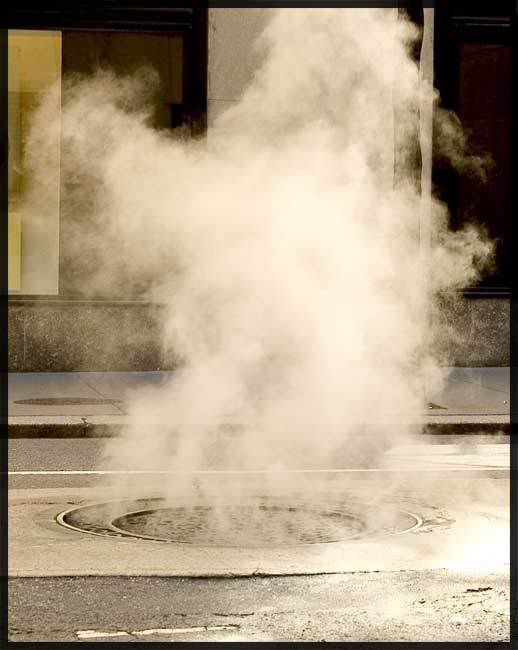












![Brotherhood" (2006) [TV-Series]](http://photos1.blogger.com/x/blogger2/1421/379621144723082/211/z/425926/gse_multipart33129.jpg)







No comments:
Post a Comment